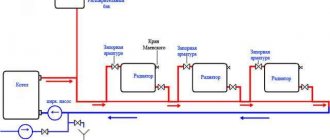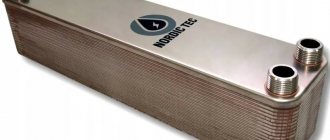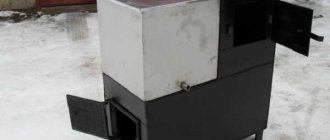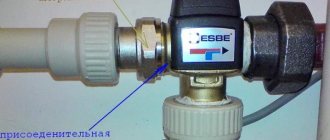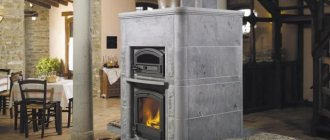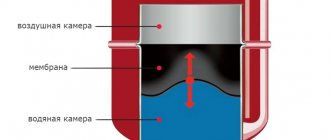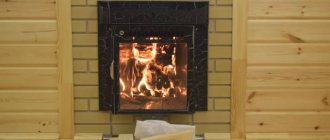Hot water is required for the sauna to function. The heat exchanger for a sauna stove provides comfort thanks to the ability to heat the liquid in the storage tank. You can spray the heater and take a shower without buying a boiler. The main thing is to find a high-quality heat exchanger for a wood-burning stove so that the performance of the device after its placement meets the needs of users. You can comply with sanitary requirements and enjoy the steam room without fear for the safety of people. Installing a heat exchanger will not take much time when choosing the optimal location for the structure.
What it is
A heat exchanger for a bath is a device that transfers heat coming from hot water up the pipe. The operation of the structure is based on the properties of the liquid. When heated, the hot water in the bath moves through a heat exchanger through a pipe into a tank located in the steam room. Cool liquid enters for heating, replacing the vacated space below. The heat exchanger in a furnace is often small. This allows the liquid to heat up at high speed. Two sections of pipeline are located at the bottom and top of the device.
The heat exchanger for the stove is located in the steam room; there are ways to place the washing compartment. Water flows independently along the lower pipe and provides operating temperature for washing when leaving. A heat exchanger for a sauna stove can be purchased inexpensively by installing the structure into the stove. The absence of adjacent devices will not disrupt the overall style of the room. A heat exchanger installed on the chimney pipe into the bathhouse significantly saves space. Methods for heating water in a bath from a stove
The heat exchanger for a bathhouse stove can be installed anywhere, at the owner’s discretion, if the model is chosen correctly. The device provides different methods of heating water:
- The “samovar” type model is located on the chimney. Warm smoke passes through the pipe, heating the water. The tap is attached to a reservoir containing warm liquid. The heating option is suitable for the compartment in the bathhouse where the shower is located.
- The stove with a heat exchanger for a samovar-type bath is small and allows the location of the tank in the washing compartment. The device heats the water.
- The heat exchanger for the bathhouse is located on the chimney.
- A reservoir plus a chimney involves heat transfer, in which internal energy is moved by water flows. Heat exchangers for stoves without controlled heat exchange are installed in the steam room. Heating is carried out in contact with the wall of the chimney pipe. The model is not protected from heat, which can lead to boiling of the liquid in the tank.
Chimney - a convector with a built-in heater is mounted in the stove and is also located near the chimney. The tank is connected by pipes with a register for the sauna stove inside the pipeline.
It is necessary to buy a heat exchanger for a heating furnace based on the choice of a specific model with special technical characteristics. Choose a design that is located inside the stove for engineering reasons. It has only one drawback - scale accumulation. Near the chimney, the water heats up slowly, but the high efficiency and the existing possibility of quick repairs can be arguments for deciding to purchase the device.
Tin pipe
Tin as a material for smelting a heat exchanger is very practical and reliable. Essentially, a chimney with a heat exchanger for a bath will look like a pipe wrapped around a smaller metal or copper tube. During the heating process from the tube, the air passing by will also warm up.
It will be enough to weld the spiral tube. Soldering can also be done with tin, previously degreased with orthophosphate acid. In this case, the heat exchanger will be secured especially securely, because it is not without reason that tin samovars are considered the standard of reliability among analog products.
Difference by type
A stove coil with a couple of holes is a simple heat exchanger for a wood stove. It uses heated water to exit through a hole at the top.
The heat exchanger for a sauna stove is installed on the chimney using two cylindrical and rectangular containers. The connecting pipeline provides good fluid throughput. Installing a heat exchanger on a sauna stove requires an anti-corrosion coating to protect the metal.
The classification of units has a variety of subtypes that involve changes in structures or components, individual elements, and materials. You can buy a heat exchanger for a bath in two types: according to the location of the tank and according to the location. The second option suggests two possibilities: in the stove or near the chimney.
The bath tank with a heat exchanger, built into the stove, heats up quickly, but there is a possibility of the liquid boiling. Replacement if damaged will be possible only after dismantling the brickwork of the furnace. The accumulation of scale is accompanied by a decrease in efficiency due to a decrease in heat transfer.
A heat exchanger for a chimney pipe into a bathhouse does not create a similar problem, since slight heating does not lead to boiling.
Installing a heat exchanger in a bathhouse under stones is not rational for those who like to take a steam bath. The temperature of the steam room will be insufficient with this arrangement of the structure.
At the location of the water tank
A sauna tank with a heat exchanger can be placed in any standard sauna compartment, be it a steam room or a washing room. The first option simplifies installation due to a small pipeline, which increases the speed of water heating. Buying a heat exchanger for a sauna stove is necessary for optimal arrangement near the chimney. The enlarged pipeline will not allow the installation of a stationary shower. The problem is resolved with the help of a flexible hose located no higher than 1.5 meters for the required liquid supply pressure.
The next option involves placing the tank in the attic of the bathhouse. But the location will require additional insulation of the device. In addition, to top up the container with liquid you will have to carry buckets or connect the water supply.
The question of how to connect the tank to the heat exchanger of a sauna stove is decided taking into account the personal preferences of the owners, based on the prepared project.
Priority for installing a heat exchanger in a steam room
The heat exchanger in the furnace is mounted on the bottom. Like a water jacket, the fuel chamber houses the structure on the inside. Some builders prefer to place the heat exchanger for a sauna stove with their own hands on the outer wall. Both devices do not allow direct contact with fire. The popularity of the internal placement method is based on a number of advantages:
- The compact device does not take up much space in the steam room.
- The water heats up quickly.
- Can be installed in a steam room or shower.
- Design safety.
Installing a heat exchanger on the inside isolates the hot tank from external influences. People do not have to worry about accidental contact with the heated surface of the container. In addition, the placement significantly saves space in the steam room.
The furnace coil, installed on the outer wall, functions as an additional source of heating for the room. The main purpose of the design is related to the problem of how to connect the heat exchanger to the sauna tank. A stainless steel pipeline about 7 meters long is connected in different ways: using a tee, fitting, connecting tube, drain valve and other components of the system. Differences in installation and operation of the heat exchanger
The heat exchanger in the bath is located between the firebox and the heating device in the following ways:
- built into the stove;
- attached to the chimney;
- located near the chimney.
The main condition for the system to work is an uninterrupted supply of water to fill the tank. Many people use a circular pump for this. Hot water in the bathhouse fills a 120-liter tank through a heat exchanger, which is enough to take a shower. A heat exchanger for a bath with your own hands must take into account the installation features:
- The total pipeline distance is no more than 3 meters. This reduces heat loss.
- The device for moving water under pressure is not used when using a pipe with a radius of 0.5 inches;
- Repeated use of methods for heating water in a bathhouse justifies the efficiency of the system.
The operating principle of the heat exchanger is based on the flow of liquid into the pipeline from a third-party reservoir. As a rule, a small pressure of liquid from the tank is enough for gravity flow. A copper or steel pipeline is placed in the stove in the form of a coil or several registers, in the shape of a spiral. Its length is about 7 meters. The degree of water heating is regulated by two taps located at the inlet and outlet.
The heat exchanger on the pipe in the bathhouse efficiently heats the water at any time of the year. Inside the stove, the device can heat the premises of a country house and be a source of warm water in everyday life. If you increase the size of the firebox and use heat-resistant materials, then the stove with a heat exchanger for the bath becomes part of the home heating system.
Principle of operation
According to the principle of operation, water heating devices are divided into 3 types:
- a coil built into the heater;
- an external heat exchanger in the bathhouse in the form of a rectangular tank, heated directly from the furnace wall;
- external water circuit that removes heat from flue gases.
In the first case, the heat exchanger is a coil made of a steel pipe, built directly into the firebox. It is positioned in such a way that the pipe is not exposed to direct flame, that is, it is outside the highest temperature zone. It is desirable that the element stands in the way of waste products of fuel combustion, then it will not burn out and will last long enough. The built-in coil for heating the water at the outlet has connections for connecting pipes leading to a remote storage tank.
In such heat exchangers, the water warms up quite quickly, but the process cannot be called effective. After all, the heater takes heat directly from the firebox, thereby reducing the heater power. The steam room takes longer to warm up, which means more wood is consumed. Hot flue gases flew out into the chimney and continue to fly out unhindered; the efficiency of the unit remains very low (no more than 50%).
An external hanging tank made of stainless steel is another option for transferring furnace heat to water. Usually it is suspended from one of the side walls of the firebox and heated by infrared radiation from it. The method is attractive due to its ease of implementation, but is not very convenient to use. In addition to the disadvantage of direct heat extraction described above, the hanging tank also requires constant addition of cold water.
Rules for installing a heat exchanger on a sauna stove
Connecting a heat exchanger in a bath offers several installation options, depending on the location of the device. The following rules apply during installation:
- The stove operates with a good efficiency factor if the heat exchanger for the stove burns no more than 15 percent of the energy.
- Water flows by gravity through the pipes if the slope during direct supply is 250 degrees, and when returning - 30 degrees.
- The installation of the structure provides for a power reserve necessary for cooling after the combustion of wood.
- It is necessary to maintain the required amount of liquid in the tank at all times. If there is not enough water, then boiling contributes to the formation of scale. Large quantities take a long time to heat up.
The connection of the tank to the heat exchanger in the bath occurs in compliance with the requirements:
- The inlet to the tank is located above the short-length upper pipe, which is used to connect equipment. This ensures good water circulation.
- The upper register is placed 1.5 meters above the floor. The bottom of the container in the steam room is located above 1.5 meters. The parameters are indicated with a stove stand no higher than 15cm.
- If there is a water supply to fill the tank, the dimensions of the location are not important.
The following connection method: the tank is placed at the bottom, a small pipe on the side. It is necessary to prevent poor water circulation when the level is lowered to the top location of the equipment. In this case, a problem will arise when supplying liquid from the tank to the heat exchanger.
Selection rules
As a rule, low-power water heaters are used to create hot water in a bathhouse: 2 - 2.3 kW. The thing is that while the steam room heats up to the required temperature, the water heater will prepare the required volume of hot water. This significantly reduces energy consumption.
The volume of the tank is selected based on the number of people in the bathhouse. As practice has shown, at a water temperature of 60°C, the consumption for taking a shower is 20 l/person. In total, for 3 people you need a boiler with a volume of 60 - 80 liters, plus a reserve of about 30% of the calculated volume.
Advice! When connecting the boiler to the electrical network, be sure to use a separate branch with a machine equipped with an RCD.
How and how to connect the external tank to the heat exchanger
Heat exchangers for baths are used in construction from heat-resistant materials. All parts that interact with the stove heat up. Therefore, the pipes are made of stainless steel. Cast iron parts are susceptible to corrosion and are unwise to use. Plastic pipelines or flexible hoses can be used when installing a bath structure with your own hands.
Modern technologies help to choose a variety of materials for construction. The main requirement is heat resistance. Tangit, paronite for seals and connections at joints and turns will be an excellent solution when building a sauna stove.
The drain valve must be connected to a water tank. Draining is done to prevent water from freezing in cold weather, which will burst the pipes. Preservation of the system for the winter will require preventive actions to maintain the functionality of the heat exchanger in the bathhouse.
Power calculations
All calculations will always be approximate; in each individual case it is difficult to determine the power that will be required to heat a room, steam room, etc.
It is generally accepted that no more than 5 kW is enough to heat an ordinary bathhouse. For example, 1 sq. m of heat exchanger (its area) is equal to 9 kW of the furnace. Keep in mind that the power will be significantly reduced after the furnace or boiler goes out, so the calculation must be made based on the surface of the furnace heat exchanger. Therefore, when calculating, try to take into account the maximum area of the heat exchanger to ensure sufficient temperature even with a one-time fire.
The shape in this case practically does not matter; it can be as different as you like. A register made of stainless steel pipes is considered the most optimal, but gradually its place is taken by a welded manifold made of two channels. A heat sink of this shape is considered less easily produced, but it does not require a lot of material for its installation and installation.
Also, do not forget to take into account the type of chimney itself; it is quite difficult to install a high-quality heat exchanger on brick chimneys, unlike metal ducts. Therefore, when giving preference to independent work, proceed from convenience.
Recommendations for use
The instructions tell you how to connect the heat exchanger to the sauna tank. When purchasing, make sure all items work. To do this, follow the recommendations:
- Check the mobility of fasteners, which may cause damage to parts that regulate air exhaust from a room with high humidity and temperature.
- It is necessary to buy a heat exchanger for the furnace with heat-resistant parts.
- The container should be small and contain the amount of water heated using a heat exchanger in two hours.
- Purchasing elements separately requires correct compatibility in a single design according to technical parameters.
- The heat exchanger for a sauna stove should use no more than 15 percent of the energy of the power of the entire structure.
Operating a heat exchanger in a sauna stove involves regularly inspecting the tank for fullness and regulating the temperature of the outlet liquid. When installed correctly, the device does not affect the chimney. Fire-resistant materials ensure safety during operation.
Air type register
The main purpose of the heat exchanger is to transfer energy from the combustion products in the chimney to the coolant, which is water or air. Heat exchangers installed in chimneys (this applies to water modifications) are often called economizers.
These devices collect and transmit heat into the room, which simply goes into the atmosphere, so that the thermal energy generated by the furnace is used to the maximum. In addition to ordinary tap water, other liquids are sometimes used - oil or anti-freeze.
In this regard, all devices are divided into two large categories:
- air;
- liquid (water).
The choice of one type or another depends on several factors. The most important of them are the configuration and material of the chimney, as well as the characteristics of the device itself.
Air heat exchanger diagram. It is considered less efficient than its liquid counterpart, but has a simple design, making it suitable for DIY
Some partitions (dampers) are not soldered, but made movable. By sliding the metal plates in/out, you can adjust the traction force, thereby reducing or increasing the performance of the heating device.
Air heat exchangers are called convectors, since their operation is based on the principle of convection. Cold air from the room enters the device, where its temperature rises due to the influence of hot flue gases. When heated, it moves further through another hole - back into the room or into the heating system.
Sauna stove with boiler
A sauna stove with a boiler is popular among users due to its efficiency. The efficiency of the device increases due to the introduction of equipment for the use of exhaust gases in order to increase productivity. The water in the bath is heated using gases. The temperature of the liquid reaches a comfortable value for washing dishes and meeting household needs.
Vesuvius skiff 16 th
Vesuvius skiff 16 VChT has a heat exchanger for a furnace with an internal water heater. It is located on the left or right side, depending on the model. The built-in mesh provides an attractive appearance of the structure. The steel firebox has thick walls up to 8mm. The entire structure is sealed.
To fix the parts, a bolted connection is used. The metal base of the casing is coated with heat-resistant paint. At the junction between the elements, the ceramic cord is resistant to temperatures of 1200 degrees. A durable sauna stove has a combustion tunnel that allows you to load firewood from the adjacent room.
Tornado 20m2
Tornado 20m2 has an internal heat exchanger for a stainless steel bath. The oven itself is durable and has a cast iron door. Heating of water in the bathhouse using a heat exchanger built inside occurs quickly, retaining heat for a long time. A powerful device requires strengthening the installation site on the floor. The heavy construction has a long service life and is easy to use.
Harvia 20 sl boiler
The attractive Harvia 20 sl boiler from a Finnish manufacturer weighs 80 kg. The spacious design accommodates 45 kg of stones, which are used to reflect heat and generate steam. The remote sauna device has a built-in condenser and is designed for a steam room with an area of 20 square meters. Stable legs reliably fix the location of the stove with a stainless steel frame.
Geyser
Such a device can operate either from a central gas pipeline or from a cylinder. Here everyone chooses for themselves. Experts note that both devices are very economical, based on the level of efficiency.
Also, a geyser is chosen for a number of the following advantages:
- Easy to use, no need to waste time and effort loading fuel;
- Speed of work;
- Compactness of the device.
If you look at the technical characteristics of such a device. It consists of a burner and a coil, which is made of a radiator. Water heating occurs according to this scheme.
The liquid flows along the coil, increasing the usable area to a straight pipe and the water is heated. The temperature of the liquid can be anything. To do this, it is adjusted with a special lever located on the gas boiler.
Installation and connection of the heat exchanger and tank in the bath
To solve the problem of how to properly connect a heat exchanger in a bathhouse, you need to study the instructions. The basic provisions of step-by-step actions will ensure the safety of the installed structure during operation. The connection diagram for the heat exchanger and tank in the bath suggests:
- Determine the location for installing the water tank. A heat exchanger for a bath on a pipe will require drawing up a custom drawing.
- Use dowels to secure the tank rails so that the hot area does not touch the wall.
- Secure the assembly on a vertical plane with fasteners for reliability.
- Four sections of pipeline will be needed to equip the tank. One for connecting the shower, two for directing the flow of water, close one with a valve.
- Attach the drain tap.
- Check the heat exchanger in the sauna stove for leaks.
A heat exchanger for a stove in a bathhouse with your own hands requires high-quality testing to ensure fire safety. How to check all the elements correctly? In this matter, it helps to study the principle of operation of the heat exchanger in the bath, based on the supply of warm liquid by gravity at the outlet from above.
What you need to know about operation
It is necessary to buy a heat exchanger for a sauna stove from a time-tested manufacturer. After reading the operating instructions, make sure that the necessary conditions are met. You can buy a heat exchanger for a wood-burning stove only if all elements are in working order. Check the heat resistance of the materials according to the specified technical specifications. When operating a stove with a wood-burning heat exchanger, it is necessary to monitor the chimneys and clean them of carbon deposits.
Do not close the damper until the fuel has completely burned out in a hot water furnace or any other model. Carbon monoxide quickly fills a room when equipment is faulty. Therefore, keep an eye on the factors that affect your wood stove heat exchanger. Its operation is correct if the system is started with a full tank, the component parts are in good condition, and there is no scale in the water container.
Operational safety
Installing a heat exchanger in a bath requires the following precautions:
- Avoid attaching pipes to the wall. The contact of hot structures with the surface increases the risk of fire.
- Make sure that heat exchangers for furnaces are always connected to a reservoir that has enough water. Its absence leads to the formation of scale and increases the fire hazard during operation.
- Monitor the operation of the system, which includes a heat exchanger in a bath on a pipe, and inspect the structure.
- Use heat-resistant materials when installing a heat exchanger for a sauna stove with built-in parts that ensure the operation of the system.
In order to buy a heat exchanger for a furnace in good condition, you need to check the availability of accompanying documentation, a certificate indicating the technical characteristics of the device.
Recommendations for installing the heat exchanger
The connection diagram for the heat exchanger in the bath depends on the specific design model. Devices have different resistance to overheating. Frame systems and a register for a pipe in a bathhouse are installed in brick structures. During construction, the apparatus is placed in the upper part of the firebox or in the roof of the furnace, on the chimney. The pipes are located on the rear or side.
A coil for a wood-burning stove, made of copper or stainless steel, is embedded in a vault or installed on a vertical wall. The twisted coil of the stove is placed on the chimney or above a tank with warm water. The container heats water for showering. The box and register heat exchanger for the bathhouse stove is located inside the stove so as to reduce metal contact with the hot area.
Experts recommend installing the heat exchanger in the bathhouse in such a way that heat comes in the form of radiation from the walls and ceiling. To do this, install stainless steel sheets along the pipes. Efficiency increases, the liquid in the tank with a heat exchanger for the bath is heated evenly.
Traditional heating systems
In search of a universal solution, craftsmen tried many options and each of them is good in its own way.
It cannot be clearly said that there is a universal option, so the choice should be made depending on the conditions existing at a particular site.
- In the process of building a bathhouse, many modern owners prefer to take the easiest route and purchase an electric boiler. The option is undoubtedly worthy, but it requires a constant supply of water, plus for a large capacity the energy costs will be sensitive.
- A water heating tank built into the stove is considered a classic. Such containers heat up quickly, the installation instructions for such heaters are the simplest; in the most affordable option, it is enough to place the tank on the stove. But it will be located low and, being in the steam room, will become a source of wet steam, which is not always good.
- Remote tanks have proven themselves well when the main tank is mounted at a comfortable height in a dressing room or shower, and heating is carried out through a heat exchanger installed in the firebox. They work thanks to the elementary laws of physics: cold water enters the heat exchanger through the lower pipe and, when heated, returns back through the upper conduit.
- But the most profitable and convenient to use are those containers mounted directly on the chimney; we will talk about them further.
The simplest heat exchangers
Having understood how the heat exchanger works in a sauna stove, it is easy to imagine the simplest devices. This is a section of pipe curved in the shape of a spiral, a coil. It is made of aluminum or copper. The material must be plastic and have anti-corrosion properties. Heating is carried out by hot air. At the end of the pipe a thread is made for a fitting connection with the tank.
Do-it-yourself sauna stoves with a heat exchanger are made in different shapes. A common variant is the horseshoe. Some craftsmen make a register for a bathhouse, providing the welded elements with a reliable fastening. They are placed in spacious heaters due to their large size.
Coil for furnaces
A stainless steel coil for a stove is a practical device consisting of pipes of plastic material. This is copper or aluminum, which bends easily and is resistant to corrosion. You can buy a coil for a wood-burning stove for installation inside the stove or on the chimney. In this case, the latter must be metal. Ceramics heats up weakly and does not transfer the necessary heat to a metal structure.
When making calculations before installing the furnace structure, it is necessary to take into account that the length should be no more than 3 meters. Then the water will move through the system by gravity.
Rectangular tank on a pipe
The heat exchange container can be rectangular in shape. The operating principle of the airtight steel casing is the same as that of other models. The liquid, under the influence of temperature, rises up into the reservoir, and the cooled liquid goes back. The answer to the question of how to connect the tank to the heat exchanger of a sauna stove involves the use of a chimney. The diameter of the device will be 115 mm without an adapter. If you use an element, then – 110mm. The operation of the system is affected by its tightness. Subject to operating conditions, the connected structure does not allow steam to enter the room. The main thing is to regularly replenish the reservoir with liquid. Recommendations from experienced professionals
Experienced craftsmen advise how to install a heat exchanger on a sauna stove, making optimal use of space and technical characteristics of parts:
- To ensure gravity flow of water, make the pipeline at a slope of 50 degrees, otherwise you will have to use a circulation pump.
- Select a small container for the system so that the water has time to raise the temperature.
- Check the tightness of the structure, which affects the operation of the system.
The heat exchanger for the furnace is made of durable materials. The durability of the structure is determined by correct calculations. The project, drawn up taking into account the recommendations, is easily implemented, providing comfort to everyone who decides to take a steam bath in a wood-fired sauna.
The video of how a universal heat exchanger works demonstrates the basic principles and rules for installing the system.
Video description
The video will show what a sauna stove with a heat exchanger is:
Siphon type
Quite effective, but not very popular method. A storage tank is installed at some elevation from the surface of the furnace. From its bottom, at an angle, a pipe with a sealed end goes into the hearth. In this case, you cannot do without boiling.
It starts at the end of a sealed pipe. The water turns into steam bubbles, which begin to rise to the top. In a cold environment, they burst and heat the surrounding water. Additional heating also occurs due to the usual convention of warm water rising to the surface and cold water taking its place.
How to make a heat exchanger with your own hands
The heat exchanger for a wood-burning stove is made independently. If you use copper and aluminum as the main materials, you will be able to avoid welding. You can buy a furnace coil with a water circuit, placing it on the outside of the furnace. Using cast iron radiators will help you design your own model of the system. The main thing is to take into account the thermal conductivity of materials.
It is necessary to begin work by preparing the project, assessing the size and functionality of the stove. The coil can be made from a pipe 2 to 3 meters long. The size of the part affects the heating rate. Another option involves a heat exchanger for a bath made from a welded pipeline. It’s easier to cover it with bricks when building a stove than to disassemble the structure later. Whatever option you choose, take care of the tightness and heat resistance of the fasteners. Use seals with increased heat resistance. Compliance with safety rules is necessary to prevent dangerous situations when operating a heat exchanger for a sauna stove made by yourself.
Briefly about the main thing
If a classic wood-burning stove is used to heat the bath, then a heat exchanger must be installed in the storage tank to heat the water. It will significantly reduce costs. For example, there will be no need for an electric boiler.
The operating principle of the heat exchanger is very simple. But there are many designs. The owner will have to choose the most acceptable one only individually. Because there is no universal way. And you just need to decide on the spot which one is best suited. And the decision will be influenced by the material from which the stove is made and the location of the storage tank.
Coil installation method
You can install a coil heat exchanger on the chimney of a sauna stove or potbelly stove in a garage or shed. It will serve for heating or for heating water.
To work you will need:
- aluminum or copper tube up to 3 m long;
- 2 3/4″ fittings and a flexible hose for hot water;
- boiler with a float valve for filling with water and a valve for its use;
- tap for draining coolant from the system.
The system installation technology looks like this:
- The first step is to bend the tube so that its cross-section remains unchanged. For copper pipes less than 28mm in diameter, you can use a pipe bender without heating them. But steel, aluminum and products with large diameters require preheating with a blowtorch.
- For bending, you can use dry sand, filling the pipe with it and closing it with plugs on both sides. A spiral bend is made according to the sample, after which sand is poured in and the pipe is washed under water pressure.
- At the end parts of the tube, threads are cut for adapters for fittings, and then connected to the system.
- The resulting coil is mounted on the chimney. If you solder it with tin to the pipe, the heat transfer will be better. Preliminary degreasing is carried out with orthophosphoric acid.
- A storage tank is hung on a support or on the wall a little above the coil. Connect it to the heat exchanger with a flexible connection and install a tap at the bottom of the tank.
Pros and cons of different designs
Depending on the circumstances, individual advantages may outweigh the disadvantages. It is clear that if the tank is located on the stove or attached to the side, then three unpleasant things follow from this:
- Constant heating of water will lead to the formation of steam, but it will not be the steam heated over 100 degrees, which is called light - it is obtained only from overheated stones. And the usual heavy steam will pour out of the container, which makes it difficult to stay in the steam room.
- Using heated water for washing is problematic if the steam room is not combined with a steam room. You will have to carry hot water to the washroom and wash the way your ancestors washed).
- In tanks built on the side of the stove, heating occurs the worst, because the walls of the stove do not heat up as much as the top or chimney. Plus, over time, the wall of the tank itself will lose thermal conductivity due to scale, and the wall of the furnace will lose its thermal conductivity due to scale. Therefore, the water does not warm up well, remains cold at the bottom, and must be stirred manually.
However, such structures also have advantages - they are easy to fill with water precisely because the container is not located high. But this is if there is no cold water supply either. Otherwise, the plus is leveled out.
By the way! The larger the contact area between the container with water and the oven, the faster the heating. But this is not always worth striving for - why do you need clouds of heavy steam in an unheated bathhouse?
Of course, you still have the opportunity to set up a shower from any tank. And, although stove makers do not recommend using a pump, the forced circulation of liquid in the system will calmly take water from either the manual or the attached tank. The main thing is not to forget to add more.
We ourselves consider the optimal system to be one in which the tank is mounted on the chimney. Whether it will be a large tank or a heat exchanger depends on how you are more accustomed or more comfortable to wash. Well, or whether there is a pump in the system or not.
Photo: samovar-type heat exchanger
However, the optimal system also has its drawbacks. In particular, traders admit that the connection between the tank and the pipe at the inlet below can suffer greatly from overheating, for example, in a situation where water is poured after the stove has been lit. Then the seam splits and needs to be welded. Another drawback is that the pipe burns out when the furnace heats up too much.
Pay attention to the size of the filler hole. For some tanks it is large, it even has a hinged lid, while for others it is small and round. Still, you will have to fill tens of liters, and also wash the inside of the tank from time to time!
Still, you will have to fill tens of liters, and also wash the inside of the tank from time to time!
On a note! The stove should not be heated to the limit of its capabilities. This shortens the service life of the metal, which inevitably oxidizes and turns into scale, and then it crumbles and holes remain. The bottom piece of the chimney will also burn out if you heat it like this. If you don't want this, insert a piece of black structural steel pipe of the required diameter inside. It will take away some of the heat and add strength to the structure.
Useful video
This video explains in more detail about strengthening the chimney with pipe cutting:
You can learn more about the disadvantages of a hinged and chimney-mounted tank from the following videos:
https://www.youtube.com/watch?v=S5TRvRjgmLs
Materials
When choosing a tank for a bathhouse or when making it yourself, an unmistakable choice of the material for its manufacture is extremely important. The heating time of the liquid, the period of its cooling and the duration of operation of the device itself will depend on this. Among the most widely used materials, cast iron, stainless steel and enameled steel are widely used.
Previously, only cast iron tanks were used for hot water tanks. Cast iron containers have been tested by time and have a number of positive aspects. In particular, a cast iron tank will keep the water hot for a long time. There is no corrosion on them and the water in this tank will always be clean. This material is very resistant to temperature changes. And finally, the shelf life of a cast iron tank is very long, since this material is not susceptible to corrosion. Currently, not many manufacturers are engaged in the manufacture of cast iron tanks. But it is quite possible to buy a used tank at a lower price. In this case, you will need to process it and give it a pleasant appearance.
One of the disadvantages is the rather long time it takes to heat the water in the tank. Cast iron tanks are heavy and sometimes need to be installed on a special foundation. If the tank is located above the stove, its fastening requires additional reinforcement. Making such a tank yourself will also be a very problematic undertaking.
Stainless steel containers are now used quite often. This material replaced cast iron tanks. The owners of the baths appreciated their high positive qualities. Such tanks do not require additional protection from high humidity. The water in a stainless steel tank heats up in an extremely short period of time. Stainless steel has good resistance to sudden temperature changes and, accordingly, does not rust, as its name already implies. The only downside that can be noted is that the water in it cools down quickly.
Tanks made of enameled steel are also a popular option for this design. A special enamel coating on such tanks reliably protects them from corrosion. The main thing is to prevent damage to the enamel, otherwise the tank may begin to rust. Although damaging the enamel layer is quite problematic, since such a coating is resistant to various types of damage. If necessary, a tank made of this material can be very easily cleaned. Enamel of various colors is available on the market.
For cold water, separate tanks are now rarely used, since it most often enters the room through the water supply. But if there is a need to install a container for cold water, then there is much less hassle with it than with a tank for hot water, since there are no particularly strict requirements for it. You can even use wooden containers, such as an oak barrel. Plastic containers for cold water are also popular. But such containers cannot be placed in a steam room, much less near a stove, because plastic is sensitive to high temperatures and can become deformed when heated. You can also make such a tank yourself.
